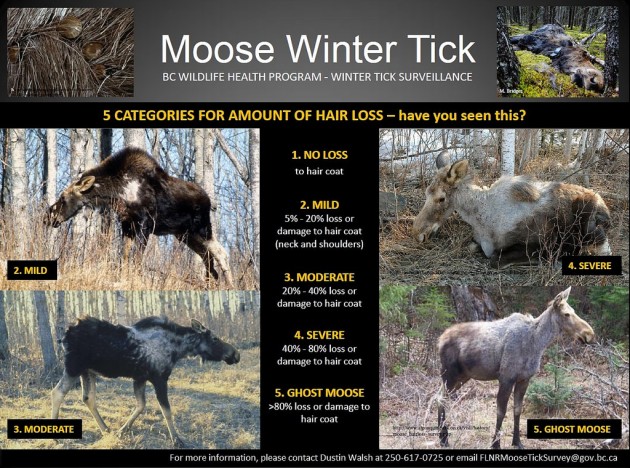Monitoring Moose For Winter Ticks – Your Help Needed
poster courtesy BCGov
Prince George, BC – For the second year in a row, the Ministry of Forests, Lands, and Natural Resource Operations is looking to the public for help in monitoring BC’s moose population for winter ticks.
Regional Wildlife Biologist, Mike Bridger, says the findings are another ‘piece’ in the population management puzzle. “We definitely have pretty strong evidence that there’s been declines in moose populations in certain regions within the province, specifically within the Central Interior.” According to ministry figures, BC’s moose population was estimated to be between 120-thousand to 205-thousand in 2014.
“There is ongoing moose research right now to try to determine what is influencing the population decline – winter tick may play a role,” says Bridger. “I don’t personally believe that they are a significant factor, but they could be part of the puzzle.”
Last year served as a pilot for the citizen surveillance program, which helps BC Wildlife health staff monitor both the severity of infestations and the distribution of tick outbreaks across the province.
Bridger says most of the surveys came from the Prince George-Omineca Region, the Peace Region (Dawson Creek and Fort St John), and the Skeena Region near Smithers. “We had very good results and a lot of input from the public, so we’re hoping to receive that again this year and, hopefully, exceed last year’s observations.”
Wildlife staff have developed a model to potentially predict the severity of tick infestations based on winter weather – snowpack level and temperatures. With last year being so mild, Bridger is expecting to see fairly high tick numbers this year. And, based on this year’s almost non-existent winter, tick infestations could be very severe next year.
The implications of a tick infestation are serious. There can be as many as tens of thousands of winter ticks on one moose. As they mature, the ticks feed on the animal’s blood and can cause anemia. Bridger says moose become distracted with ticks, spending a lot of time rubbing and scratching, and less time foraging and being vigilant for prey. The extent of hair loss is a rough indicator of the number of ticks present and that’s what citizens are being asked to document.
Anyone interested in contributing to the surveillance program can click here to download a copy.


Comments
Couldn’t we just add a tick controller to salt blocks and drop them off out in the bush by chopper?
There is ongoing moose research right now to try to determine what is influencing the population decline – winter tick may play a role,” says Bridger. “I don’t personally believe.
How about showing the stats of how many are killed by CN rail every year.
But no government wants to tackle them.
you can include wolves and bears as well.
One might well say “what moose?”
We are seeing very few moose this winter, in our rural area north of P.G.
We noticed a decline beginning a few years ago.
We would normally see a moose or two every few days, now it is rare to see one in a month. The ones we have seen do not appear to be suffering from tick infestation.
There are definitely a lot more wolves in our area though, it has become the new normal to see or hear wolves around here, whereas in the last 16-18 years it was rare.
In other news, we saw a beautiful Lynx the other day, best and longest view I’ve ever had of one, as he strolled nonchalantly along the creek.
Need more bounties on wolves, I think they are driving down the ungulate population.
metalman.
What Moose is so true. They came in to this area in 1920, they’ve either been killed off, or they’re doing a migration of sorts to other areas. Last fall I hunted an area where moose were very plentiful only to find no moose or deer tracks, but a lot of wolf tracks. Sad to see.
Well, they’ve done a wolf cull in the Kootenays, now they’re up in the Peace. Trappers are finding it too expensive to go after them locally, so a bounty is needed I think.
Yes, kill the big bad wolf, they are the harbinger of all that is bad in our ecosystem. If those that profess to be outdoorsmen took a step back & looked at this issue logically you would see that predators are only doing what they are meant to do, no more. The reasons for declining moose populations are far more complex & multi faceted than simple predator/prey relations. Why are wolf populations rising? If moose were their primary food source logic dictates that wolf populations would decline as well. They are not so what are wolves eating? That would be a good place to start. Why do I see elk, caribou & deer in areas that moose used to thrive in? Moose are not indigenous to this area so maybe nature is balancing itself? The answer or solution to this issue is going to be as complex as the problem. Wholesale decimation of predators will not solve anything, in fact it will make the issue worse.
Comments for this article are closed.